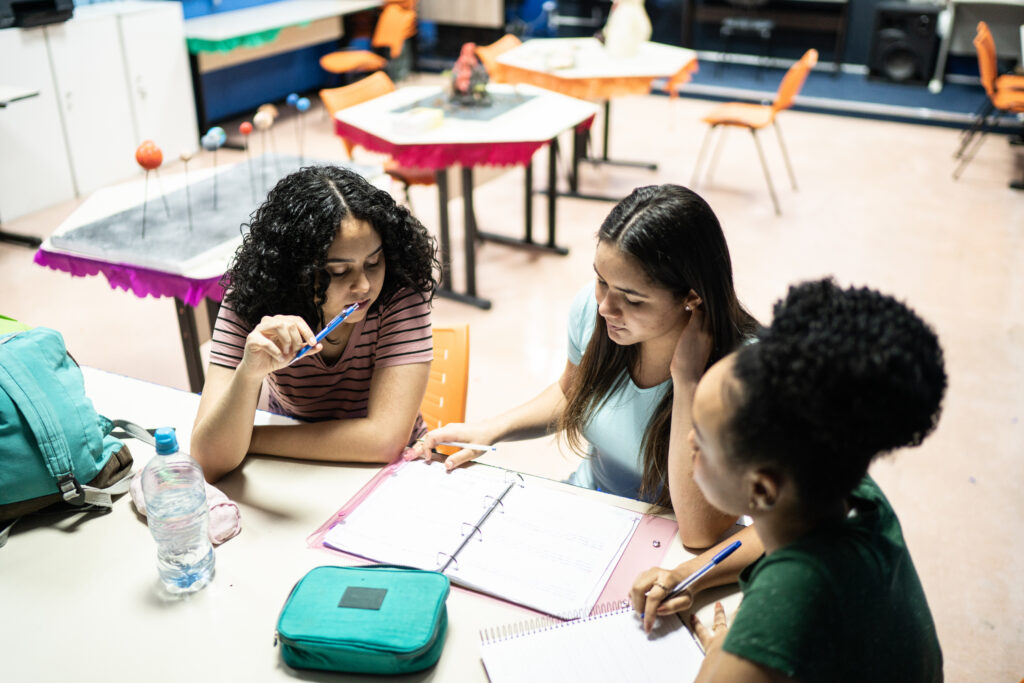This post was written by NCTE member Kristen Kalenowicz.
It is common for teachers to assign a reading and provide students with a series of questions about the text: What does Allie’s baseball mitt symbolize? How does flashback establish the relationship between Amir and Hassan?
But when teachers ask all the questions, the teachers remain the arbiters of what is important, or discussion-worthy.
Higher engagement occurs when we give the power to students by allowing them to craft the questions, drive the discussion, and reflect on the experience.
Over the last decade teaching high school English, I’ve modified the popular Fishbowl strategy to give students more control over classroom discussion. Here’s how you can implement this activity in your own classroom:
- Teach students to write effective discussion questions about any text.
Share examples of thought-provoking, open-ended questions, uncover what makes them effective, and practice writing original questions based on short texts. I show brief nonfiction films from Film Club by The New York Times’ Learning Network, and my students work with partners to test their questions and consider which provoke discourse.
- Share appropriate ways to respond during discussion.
Model the language used to agree, disagree, ask for clarification, and build on others’ ideas. I display a list of sentence-starters and provide a copy of the language for students to reference as needed. I’ve found students are often missing the language to disagree respectfully. Practice using the language during low-stakes conversations, and remind students to address one another by name.
- Let students vote on the questions they want to discuss.
Now that you’ve front-loaded a bit, prepare to discuss your course’s anchor text by having each student write two-three questions they’d like to discuss with their peers. I encourage students to write questions that focus on the author, the text, and their own experiences and world.
Recently, the following questions posed by a freshman and a sophomore stimulated lively conversations in their respective classes:
-
- What would you say to Holden if he went to our school? How do you think others would react to him (teachers, counselors, upperclassmen)?
- Why didn’t Amir help Hassan fight back? What would you have done in Amir’s situation?
After reviewing all questions, use Google Forms to compile a master list of questions that students will vote on. Could a particular student use a boost of confidence? Include their question in the master list, and watch their smile bloom!
- Provide ample class time for students to write their responses using the anchor text as support.
The act of digging into a physical copy of the text and finding supporting quotations reinforces the language and context. Also, since the work is happening in front of you (rather than at home or on a device), you can easily identify students who are struggling, and offer support. At this stage, I make it a point to connect with anyone who seems nervous to speak in front of the class.
- Set up the room, and begin with a single question.
Arrange the room into two concentric circles with the center consisting of six desks. Four students sit in the center circle, leaving two seats empty. These four volunteers, with just their novel and written responses in hand, begin the discussion.
- Engage all students in the discussion.
The rest of the class does not remain passive. At any point in the conversation, other students jump into the empty seats to ask questions, build on ideas, share opinions, or seek clarification.
Additionally, those in the outer circle are responsible for using a feedback form to jot ideas that stand out to them. The goal is not for students to have their head down writing, so this form is brief. Many students use the form to also scrawl ideas they want to address when they jump in the circle.
- Debrief and reflect.
At the end of each round, I thank participants and point out specific strengths. At this stage, students feel vulnerable, so I praise the desired behavior rather than point out things to change. The magic happens, though, when the students join in with praise for each other.
At the end of class, students use the feedback form to reflect on their own participation and to assess the degree to which they met the objectives. This step is crucial because it provides the space to consider actions they’re proud of and what they might adjust for next time. It also serves as a valuable communication tool between student and teacher.
Finally, students share aloud what worked and what we as a class might do differently. I elicit suggestions, and we make adjustments during the next discussion. Some of these adjustments end up being implemented and then ultimately rejected by the group, but the important thing is the students are invested, and they get a voice in how their classroom runs.
The most powerful conversations occur when students are given the space to talk about what interests or angers or perplexes them. It is our job as teachers to provide the guidelines and the support, and then to step aside and let them speak.
It is the policy of NCTE in all publications, including the Literacy & NCTE blog, to provide a forum for the open discussion of ideas concerning the content and the teaching of English and the language arts. Publicity accorded to any particular point of view does not imply endorsement by the Executive Committee, the Board of Directors, the staff, or the membership at large, except in announcements of policy, where such endorsement is clearly specified.
 Kristen Kalenowicz teaches English, creative writing, and AP Research at Cedarburg High School in Wisconsin. She is the club adviser for the Writing Arts Club, which publishes the school’s literary magazine. She previously taught in the Milwaukee Public School District and in Madrid, Spain. Follow her on Twitter @KristenKaleno.
Kristen Kalenowicz teaches English, creative writing, and AP Research at Cedarburg High School in Wisconsin. She is the club adviser for the Writing Arts Club, which publishes the school’s literary magazine. She previously taught in the Milwaukee Public School District and in Madrid, Spain. Follow her on Twitter @KristenKaleno.

